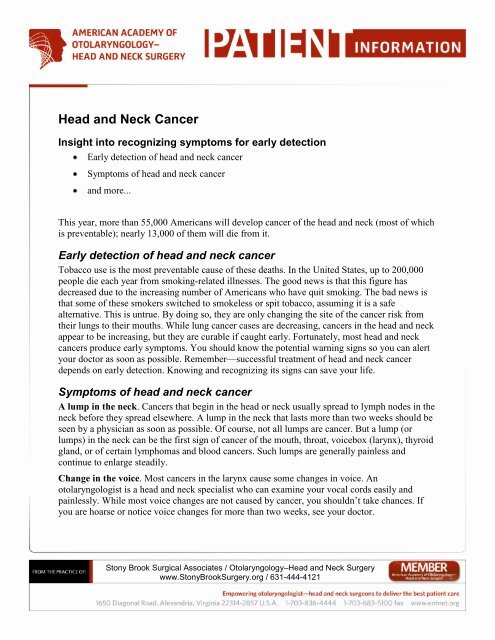Head and Neck Cancer - Stony Brook University School of Medicine
Head and Neck Cancer - Stony Brook University School of Medicine
Head and Neck Cancer - Stony Brook University School of Medicine
Create successful ePaper yourself
Turn your PDF publications into a flip-book with our unique Google optimized e-Paper software.
<strong>Head</strong> <strong>and</strong> <strong>Neck</strong> <strong>Cancer</strong><br />
Insight into recognizing symptoms for early detection<br />
Early detection <strong>of</strong> head <strong>and</strong> neck cancer<br />
Symptoms <strong>of</strong> head <strong>and</strong> neck cancer<br />
<strong>and</strong> more...<br />
This year, more than 55,000 Americans will develop cancer <strong>of</strong> the head <strong>and</strong> neck (most <strong>of</strong> which<br />
is preventable); nearly 13,000 <strong>of</strong> them will die from it.<br />
Early detection <strong>of</strong> head <strong>and</strong> neck cancer<br />
Tobacco use is the most preventable cause <strong>of</strong> these deaths. In the United States, up to 200,000<br />
people die each year from smoking-related illnesses. The good news is that this figure has<br />
decreased due to the increasing number <strong>of</strong> Americans who have quit smoking. The bad news is<br />
that some <strong>of</strong> these smokers switched to smokeless or spit tobacco, assuming it is a safe<br />
alternative. This is untrue. By doing so, they are only changing the site <strong>of</strong> the cancer risk from<br />
their lungs to their mouths. While lung cancer cases are decreasing, cancers in the head <strong>and</strong> neck<br />
appear to be increasing, but they are curable if caught early. Fortunately, most head <strong>and</strong> neck<br />
cancers produce early symptoms. You should know the potential warning signs so you can alert<br />
your doctor as soon as possible. Remember—successful treatment <strong>of</strong> head <strong>and</strong> neck cancer<br />
depends on early detection. Knowing <strong>and</strong> recognizing its signs can save your life.<br />
Symptoms <strong>of</strong> head <strong>and</strong> neck cancer<br />
A lump in the neck. <strong>Cancer</strong>s that begin in the head or neck usually spread to lymph nodes in the<br />
neck before they spread elsewhere. A lump in the neck that lasts more than two weeks should be<br />
seen by a physician as soon as possible. Of course, not all lumps are cancer. But a lump (or<br />
lumps) in the neck can be the first sign <strong>of</strong> cancer <strong>of</strong> the mouth, throat, voicebox (larynx), thyroid<br />
gl<strong>and</strong>, or <strong>of</strong> certain lymphomas <strong>and</strong> blood cancers. Such lumps are generally painless <strong>and</strong><br />
continue to enlarge steadily.<br />
Change in the voice. Most cancers in the larynx cause some changes in voice. An<br />
otolaryngologist is a head <strong>and</strong> neck specialist who can examine your vocal cords easily <strong>and</strong><br />
painlessly. While most voice changes are not caused by cancer, you shouldn’t take chances. If<br />
you are hoarse or notice voice changes for more than two weeks, see your doctor.<br />
<strong>Stony</strong> <strong>Brook</strong> Surgical Associates / Otolaryngology–<strong>Head</strong> <strong>and</strong> <strong>Neck</strong> Surgery<br />
www.<strong>Stony</strong><strong>Brook</strong>Surgery.org / 631-444-4121
A growth in the mouth. Most cancers <strong>of</strong> the mouth or tongue cause a sore or swelling that<br />
doesn’t go away. These may be painless, which can be misleading. Bleeding may occur, but<br />
<strong>of</strong>ten not until late in the disease. If an ulcer or swelling is accompanied by lumps in the neck,<br />
you should be concerned. In addition, any sore or swelling in the mouth that does not go away<br />
after a week should be evaluated by a physician. Your dentist or doctor can determine if a biopsy<br />
(tissue sample test) is needed <strong>and</strong> can refer you to a head <strong>and</strong> neck surgeon who can perform this<br />
procedure.<br />
Bringing up blood. This is <strong>of</strong>ten caused by something other than cancer. However, tumors in the<br />
nose, mouth, throat, or lungs can cause bleeding. If blood appears in your saliva or phlegm for<br />
more than a few days, you should see your physician.<br />
Swallowing problems. <strong>Cancer</strong> <strong>of</strong> the throat or esophagus (swallowing tube) may make<br />
swallowing solid foods—<strong>and</strong> sometimes liquids—difficult. The food may “stick” at a certain<br />
point <strong>and</strong> then either go through to the stomach or come back up. If you have trouble almost<br />
every time you try to swallow something, you should be examined by a physician. Usually a<br />
barium swallow x-ray or an esophagoscopy (direct examination <strong>of</strong> the swallowing tube with a<br />
scope) will be performed to find the cause.<br />
Changes in the skin. The most common head <strong>and</strong> neck cancer is basal cell cancer <strong>of</strong> the skin.<br />
Fortunately, this is rarely serious if treated early. Basal cell cancers appear most <strong>of</strong>ten on sunexposed<br />
areas like the forehead, face, <strong>and</strong> ears, but can occur almost anywhere on the skin. Basal<br />
cell cancer <strong>of</strong>ten begins as a small, pale patch that enlarges slowly, producing a central “dimple”<br />
<strong>and</strong> eventually an ulcer. Parts <strong>of</strong> the ulcer may heal, but the major portion remains ulcerated.<br />
Some basal cell cancers show color changes. Other kinds <strong>of</strong> cancer, including squamous cell<br />
cancer <strong>and</strong> malignant melanoma, also occur on the head <strong>and</strong> neck. Most squamous cell cancers<br />
occur on the lower lip <strong>and</strong> ear. They may look like basal cell cancers, <strong>and</strong> if caught early <strong>and</strong><br />
properly treated, usually are not dangerous. If there is a sore on the lip, lower face, or ear that<br />
does not heal, consult a physician. Malignant melanoma typically produces a blue-black or black<br />
discoloration <strong>of</strong> the skin. However, any mole that changes size, color, or begins to bleed may<br />
mean trouble. A black or blue-black spot on the face or neck, particularly if it changes size or<br />
shape, should be seen as soon as possible by a dermatologist or other physician.<br />
Persistent earache. Constant pain in or around the ear when you swallow can be a sign <strong>of</strong><br />
infection or tumor growth in the throat. This is particularly serious if it is associated with<br />
difficulty in swallowing, hoarseness, or a lump in the neck. These symptoms should be evaluated<br />
by an otolaryngologist.<br />
Identifying high risk <strong>of</strong> head <strong>and</strong> neck cancer<br />
As many as 90 percent <strong>of</strong> head <strong>and</strong> neck cancers arise after prolonged exposure to specific risk<br />
factors. Use <strong>of</strong> tobacco (cigarettes, cigars, chewing tobacco, or snuff) <strong>and</strong> alcoholic beverages<br />
are the most common cause <strong>of</strong> cancers <strong>of</strong> the mouth, throat, voice box, <strong>and</strong> tongue. In adults who<br />
do not smoke or drink, cancer <strong>of</strong> the throat can occur as a result <strong>of</strong> infection with the human<br />
<strong>Stony</strong> <strong>Brook</strong> Surgical Associates / Otolaryngology–<strong>Head</strong> <strong>and</strong> <strong>Neck</strong> Surgery<br />
www.<strong>Stony</strong><strong>Brook</strong>Surgery.org / 631-444-4121
papilloma virus (HPV). Prolonged exposure to sunlight is linked with cancer <strong>of</strong> the lip <strong>and</strong> is<br />
also established as a major cause <strong>of</strong> skin cancer.<br />
What you should do. All <strong>of</strong> the symptoms <strong>and</strong> signs described here can occur with no cancer<br />
present. In fact, many times complaints <strong>of</strong> this type are due to some other condition. But you<br />
can’t tell without an examination. So if they do occur, see your doctor to be sure.<br />
Remember—when found early, most cancers in the head <strong>and</strong> neck can be cured with few side<br />
effects. Cure rates for these cancers could be greatly improved if people would seek medical<br />
advice as soon as possible. Play it safe. If you detect warning signs <strong>of</strong> head <strong>and</strong> neck cancer, see<br />
your doctor immediately. And practice health habits which help prevent these diseases.<br />
<strong>Stony</strong> <strong>Brook</strong> Surgical Associates / Otolaryngology–<strong>Head</strong> <strong>and</strong> <strong>Neck</strong> Surgery<br />
www.<strong>Stony</strong><strong>Brook</strong>Surgery.org / 631-444-4121
















